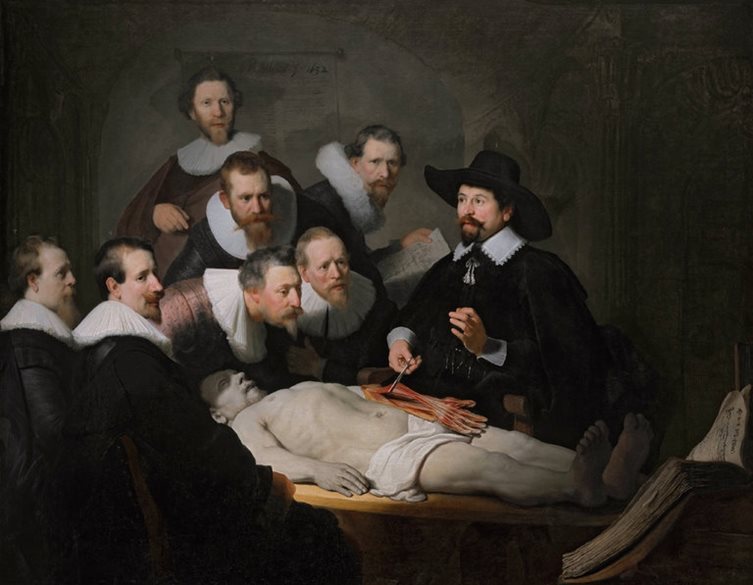What Doctors Can Learn From Looking at Art


NYTimes
It was a welcome change to find my eyes glued not to the endlessly frustrating loop of the Krebs cycle, but instead to a portrait of 19th-century aristocrats in top hats and ball gowns. The afternoon, spent at a museum of British art, wasn’t a stolen escape from medical school. It was a required class.
I stared at the painting, carefully studying each face. I took note of the intensity of a woman’s deep blue eyes, the streaks of gray in a man’s bushy sideburns. I noted details the way I had previously only pretended to when strolling through museums with more sophisticated friends. For the first time, I didn’t just look — I saw.
Then, in small groups, we described what we’d seen with our fellow medical students. The purpose was to help us become more thoughtful and meticulous observers — a skill, perhaps more than any other, that lays the foundation for good medicine.
In the coming months, the class’s lessons would creep up on me at unexpected moments during patient rounds: noting asymmetry on an old man’s face; describing angry purple blisters to a colleague; considering the shadowy contours of pneumonia on an X-ray. A picture was indeed worth a thousand words, I thought — and in my case, those were medical words I still struggled to spell, memorize and pronounce.
Therein lies the significance of learning through art: It is subtle and indirect, yet it ingrains insights deep within your consciousness. You feel and know even before you can think or speak.
Medical schools are increasingly using art to teach medicine. One of the first classes was started by Dr. Irwin Braverman, a professor of dermatology at Yale. Dr. Braverman noted that doctors in training often didn’t completely and accurately describe what they saw — instead jumping to conclusions or relying on technology to make a diagnosis. He thought asking students to describe something nonmedical, like art, might help them collect and relay visual information. His intuition was correct: Students who took his course were 10 percent more likely to pick up on important details in their patients.
This finding caught the eye of other medical educators, including Dr. Joel Katz at Harvard. Dr. Katz, a graphic designer-turned-physician and director of the internal medicine residency program at Brigham and Women’s Hospital, co-created a nine-week course in 2003 called Training the Eye: Improving the Art of Physical Diagnosis for first- and second-year medical students. Students meet weekly with curators at museums throughout Boston to study concepts ranging from symmetry and texture to form and motion. Then they apply those insights while examining patients in the classroom.
In one session, students study a limestone sculpture that appears different when viewed from various angles. They then observe the breathing patterns of patients with respiratory illnesses in different positions to determine if the problem lies in the muscles, spine, lungs or somewhere else altogether. In another session, students scrutinize John Singer Sargent’s “El Jaleo,” a large painting that portrays a dancer in motion. Afterward, they examine patients with gait issues and assess their balance, stance and step. Students who took the course made 38 percent more observations on visual skills examinations of patients than those who didn’t.
“Very early in clinical training, students stop trusting their physical exam skills,” Dr. Katz said. “They get labs and radiology to replace the exam. We’re trying to teach them to trust their vision, to look carefully before making judgments.”
Dozens of medical schools now have art programs through which they teach students not only observational skills, but also about ambiguity. Grappling with uncertainty is an essential part of practicing medicine. Even seemingly straightforward conditions like heart attacks, strokes or pneumonia often present in unusual ways that lead to misdiagnosis. Studying art can help medical students think broadly and entertain various possibilities before settling on a final interpretation.
“Ambiguity is inherent in art and in medicine,” Dr. Katz said. “In both, we have to avoid prematurely narrowing our thinking.”
Art can also help doctors understand how patients are feeling and what they might be going through. Research has found that medical students who study art are better able to interpret the emotional expressions on patients’ faces.
“There’s a lot of ambiguity in the human face,” said Ivana Viani, a medical student at Harvard who took the Training the Eye course. “There are so many nuanced expressions that often we don’t notice.”
For Ms. Viani, the class also taught her the importance of completing the picture: putting a patient’s illness into a broader context by examining not only the main character, but also the scene.
“In class, we do exercises where we’re not allowed to look at the center of a painting,” Ms. Viani said. “When you examine the periphery, it’s amazing how much detail you see. Now when I walk into a patient room, I look around. Do I see cigarettes popping out of her purse? Does she have greeting cards and flowers? Or is she alone?”
This broader perspective may be the most valuable aspect of art in medicine. In an era of proton beams and immunotherapies, art can help doctors hit the pause button — and refocus our attention on the patient. It reminds us that while medicine and technology prolong life, beauty and meaning make life worth living. And that in the end, we all just want to be seen.



Bonjour de Paris. Indeed a very good analysis but does it describe the world of today? It is my experience that while my doctors used to…